Prohibiting ninja swords: legal description and defences (accessible)
Updated 27 March 2025
Consultation start: Wednesday 13 November 2024
Consultation end: Wednesday 11 December 2024
Summary
Topic
This consultation seeks views on our proposed legal description of ninja swords to be in scope of the list of prohibited weapons and whether any defence or exemptions should be applied under Section 141 of the Criminal Justice Act 1988 (CJA).
To
This is a consultation open to the public and targeted to directly affected parties, including the police, Crown Prosecution Service, community groups, businesses and organisations with a direct interest in the proposals.
Duration
4 weeks from 13/11/2024 to 11/12/2024.
Enquiries
Firearms and Weapons Policy Unit
5th floor, Fry Building
Home Office
2 Marsham Street
London
SW1P 4DF
Email: ninja-swords-consultation@homeoffice.gov.uk
How to respond
Submit by 11/12/2024 by:
-
Completing the online form
Geographical scope
We are seeking views from across the UK. The proposals cover matters that are devolved, and which apply only to England and Wales, but we will work closely with the devolved administrations on how specific proposals might apply to or affect Scotland and Northern Ireland.
Where proposals deal with devolved matters and legislation is required, this will be agreed with the devolved administrations in accordance with the devolution settlements.
Additional ways to respond
If you are unable to use the online system, for example because you use specialist accessibility software which is not compatible with the system, you may download a PDF version of the online form and email or post it to the above contact details.
Please also use the above contact details if you require information in another format, such as “easy read”, large print, Braille or audio.
We may not be able to analyse responses not submitted in these provided formats.
Options Assessment
The Options Assessment, formerly known as the ‘Impact Assessment’ has been published alongside this consultation paper. The Options Assessment details the policy with analysis.
About
This consultation document and the consultation process has been underpinned by the Consultation Principles[footnote 1], as issued by the Cabinet Office.
If you are responding as a representative of a group, please provide a summary of the people and/or organisations that you represent. If possible, please provide a further summary on how you have reached the stipulated conclusions.
Information provided in response to this consultation may be published or disclosed in accordance with the access to information requests, such as the Freedom of Information Act 2000, and UK data protection legislation. You should note that this may include personal data, where required by law.
If you want the information that you provide to be treated as confidential, please be aware that, under the Freedom of Information Act, there is a statutory Code of Practice with which public authorities, such as the Home Office, must comply and which deals, amongst other things, with obligations of confidence.
In view of this it would be helpful if you could explain to us why you regard the information you have provided as confidential. If we receive a request for disclosure of the information we will take full account of your explanation, but we cannot give an assurance that confidentiality can be maintained in all circumstances. An automatic confidentiality disclaimer generated by your IT system will not, of itself, be regarded as binding on the Home Office.
The Home Office will process your personal data in accordance with the Data Protection Act and, in the majority of circumstances, this will mean that your personal data will not be disclosed to third parties.
In responding to the consultation from Scotland, you are however consenting for your response to be shared with the Scottish government.
Your opinions are valuable to us – and we thank you for taking the time to read and respond to this consultation.
1. Executive summary
1.1. This government has committed in its manifesto to ban ninja swords. This consultation seeks views on the proposed legal description and defences and exemptions.
1.2. Knife crime devastates families and communities across the country and the government has made a commitment to halve knife crime a decade. We will take a wide-ranging approach, with decisive action taken on those who offend, but also taking a stronger focus on prevention. We will introduce a new 10-year Young Futures programme which will aim to support young people at risk of being drawn into crime and violence or facing other poor life outcomes. This will include establishing local prevention partnerships that will identify young people at risk of violence and crime earlier and intervene more effectively. Alongside this we will introduce a network of hubs in communities which will bring together key support services for young people into one place including mental health support, employment advice and youth work. Furthermore, the government plans to place youth workers and mentors in A&E units and Pupil Referral Units to offer young people a pathway out of violence and crime. The government will also make mandatory programmes designed to prevent reoffending in young people.
1.3. We are also clear that change is needed in relation to availability of potentially dangerous weapons in the market. Following the tireless campaign of Pooja Kanda, we are committed to the introduction of a comprehensive ban on the possession of dangerous weapons. We have implemented the ban on zombie-style knives and zombie-style machetes approved by the last Parliament in April 2024. The ban came into force on 24 September and means it is an offence to manufacture, sell, supply, or possess a zombie-style knife or zombie-style machete. The government is also committed to conducting an end-to-end review of online knife sales and introducing new sanctions for the senior leaders of technology companies who breach the law when selling knives online through their platforms.
1.4. Whilst the COVID-19 pandemic saw a decline in knife-enabled criminality, data has shown that these offences have since increased. As of the year ending March 2024, the police recorded an increase in knife crime of violent offences by 4% compared with the previous year[footnote 2] . There are now 50,973 offences recorded in the year to June 2024 compared with 49,187 offences recorded in the year to June 2023.
1.5. Police recorded figures show that in the period from April 2022 to March 2023, three homicides involved the use of a sword. The government is using this consultation to seek views on how ninja swords should be defined in legislation and how wide the definition should be. It is important that we get views over our description of a ninja sword as the definition might draw in other types of bladed items that are widely used. We invite views on this description.
1.6. The government is also seeking views on whether defences should apply to these weapons in line with existing legislation for other prohibited offensive weapons, in particular Samurai swords and other swords with curved blades.
2. Background
2.1. Ninja swords are already subject to the criminal law. At present there are offences that penalise the possession of a ninja sword in public without good reason. The onus is on the person suspected of this offence to set out the reason.
2.2. There are also offences to prevent the sale and supply of ninja swords to anyone under 18 years of age. The laws on sale and delivery of knives were subject to changes in the Offensive Weapons Act 2019 that updated legislation to take account of remote sales and delivery of parcels to homes.
2.3. We are now going further with ninja swords. By adding ninja swords to the list of prohibited offensive weapons in The Criminal Justice Act 1988 (Offensive Weapons) Order 1988 it will mean that it will become an offence to manufacture, import, sale or possess a ninja sword.
3. Legal description
3.1. We want to ensure that our legal description of ninja swords serves two purposes. First that it captures ninja swords which are of concern to members of the public. Second, that it does not bring within scope of the ban swords and other bladed tools that are typically used for legitimate purposes.
3.2. There is not a precise historical description of what a ninja sword is. Ninja swords (Ninjato, Ninjaken, Shinobigatana) are used by modern Ninjutsu practitioners but there is an absence of antique examples, and the most popular design seems to have first surfaced in the 1950s. Due to the lack of a precise description, and the fact that different types of swords are being marketed in the UK as ninja swords, this creates the possibility that in an attempt to ban them, as an unintended consequence, a number of other bladed tools and other types of swords, including those that are used for legitimate purposes will also be banned.
3.3. There is a range of reasons why some swords should remain legal to own and use. We are aware that many members of the public own antique swords and swords of historical interest which are not antique. People also own modern swords as collectable items and there are also those who own swords for activities such as martial arts, fencing and re-enactment. Many British military swords have plain straight blades and are in the possession of service personnel or in the possession of family members of former service personnel when they are passed on. Furthermore, there are many machetes and long knives that are used as farming tools.
4. Proposed Legal Description of Prohibited Ninja Swords
4.1. We are aiming to provide as precise as possible legal description to the ninja swords that we intend to prohibit, and that our research shows, are marketed in the UK.
4.2. As outlined in paragraph 3.3, there are many legitimate uses of swords, which we do not intend to prohibit or restrict. As such, we have developed a description that looks at length of the blade, type of sharp pointed end and type of cutting blade.
4.3. Our proposed legal description of a ninja sword to be included in the prohibited list of weapons under Section 141 of the Criminal Justice Act is as follows:
A fixed bladed article with a blade between 14-24 inches (the length of the blade being the straight-line distance from the top of the handle to the tip of the blade) with:
(i) A single straight cutting edge; and;
(ii) A tanto style point - by tanto style point, we mean a point which is created by the main cutting-edge changing direction in a short (relative to the overall length of the blade) straight line, with an angle (between the primary long cutting edge and secondary short cutting edge at the tip) greater than 90 degrees and continuing up to form a point of less than 90 degree, where the secondary short cutting edge meets the spine. The secondary short cutting edge should not deviate in length more than 5% more or less than the width of the blade immediately after the hilt; or
(iii) A reversed tanto style point – by reverse tanto style point, we mean a point which is created by the cutting-edge changing direction in a short (relative to the overall length of the blade) straight line, with an angle (between the primary long cutting edge and secondary short cutting edge at the tip) less than 90 degrees and continuing up to form a point of greater than 90 degree, where the secondary short cutting edge meets the spine. The secondary short cutting edge should not deviate in length more than 5% more or less than the width of the blade immediately after the hilt.
4.4. A single cutting edge is a typical feature of a ninja sword. If the description included double-edged swords, it would bring into scope other types of swords that, as discussed in paragraph 3.3, we do not intend to prohibit.
4.5. A tanto point is the most common design found in ninja swords that are available in the UK market. To ensure that we capture future designs of ninja swords, we will also be bringing into scope of the ban ninja swords with a reverse tanto point. Our description may capture other single edged swords and tanto or reversed tanto knives and machetes, as an unintended consequence, such as specialised tuna knives and we are seeking views on whether there are more bladed articles that are likely to be banned as an unintended consequence. We are also seeking views on whether we should be providing defences for some of these bladed articles, such as tuna knives, and bladed articles with a tanto or reversed tanto point of other lengths will not be banned.
4.6. We are proposing a blade length of 14 – 24 inches in order to exclude from the ban common kitchen knives and traditional long swords, as well as most traditional daggers such as the Scottish Dirk. This description will also keep lawful swords which are longer such as the larger fish knives, for example specialised tuna knives, and longer straight bladed swords like traditional military swords.
4.7. We welcome views on whether the proposed legal description is sufficiently precise so it bans the ninja swords that are of concern to the public, whilst minimising the number of bladed articles that may be brought within scope of the description as an unintended consequence.
4.8. For illustrative purposes, we have provided a list below, with images, of swords that will and will not be prohibited under our proposed legal description:
Banned under new zombie-style knife and machete legislation
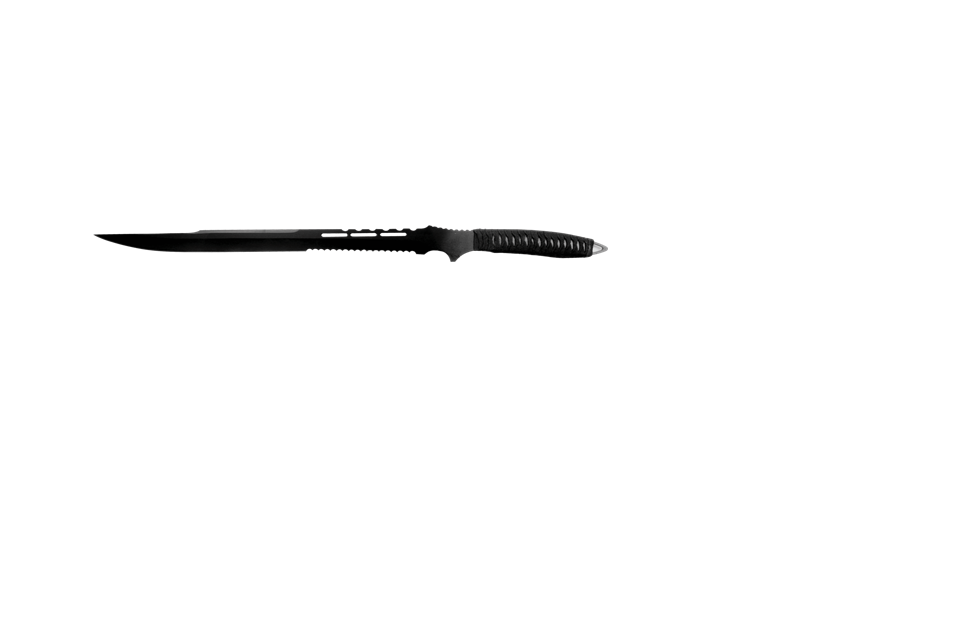
Serrated ninja sword (17.5” blade). This example will be banned by the zombie-style knife and machete legislation.

Blue ninja sword (18” blade). This example has been banned by the zombie-style knife and machete legislation.
(There are many other variations on the market in slightly different styles / colours etc. that will also fall under the zombie-style knife and machete ban)
Will be banned by proposed new ninja sword definition

This is the most common ninja sword design. Typically, they have a short, straight, plain, single edged blade of varying length (most commonly in the 17”– 24” range). Designs such as this will be banned by our new definition.

“Rainbow” ninja sword design (18.75” blade). This is similar to the sword that was used in the murder of Ronan Kanda and will be banned by our new definition.
Other items that will be banned by new ninja sword definition
We are aware that some specialised knives, such as the tuna knife below will be banned, as an unintended consequence, but shorter and longer tuna knives will remain available.
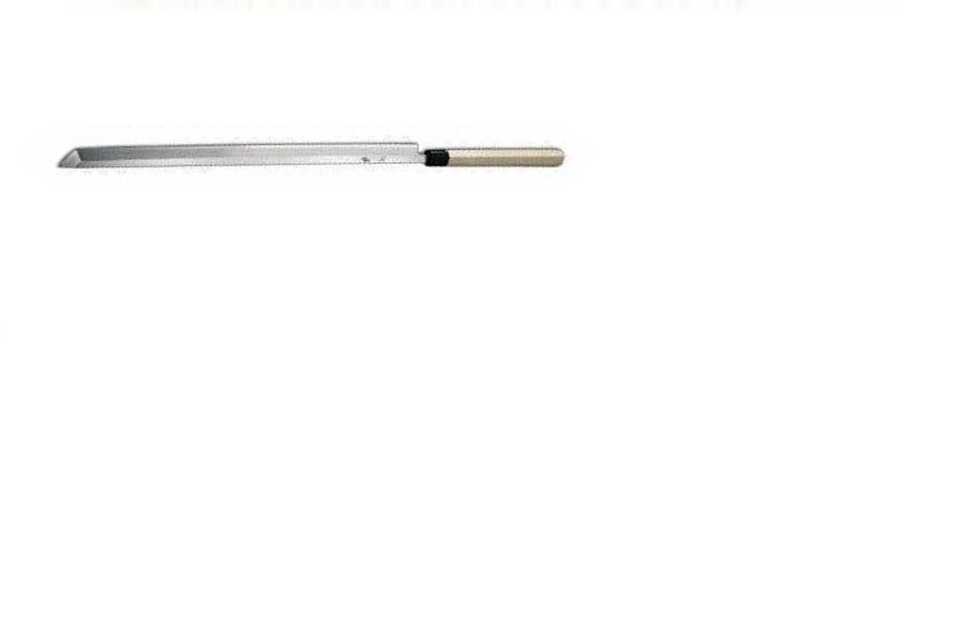
Maguro Bocho (Tuna Knife) (21” blade) – whilst examples between 14” and 24” will be prohibited shorter or larger examples will still be permitted.
Kitchen knives that will not be banned by the new definition
There are a number of kitchen knives with long blades which we do not intend to ban. This is why our definition of a ninja sword starts at 14” blade length and why we have set out the length range at 14-24 inches.
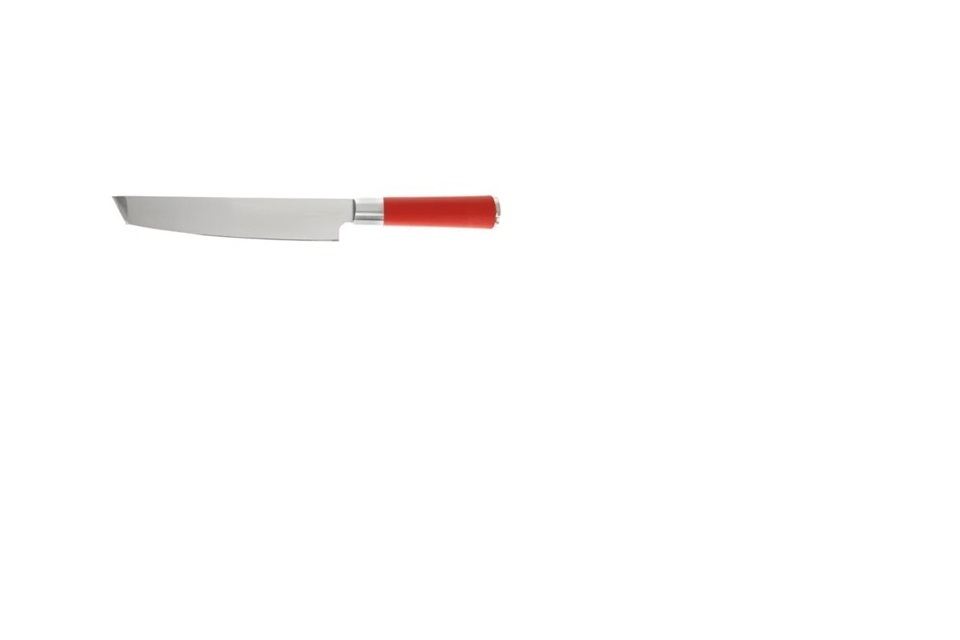
Kitchen knife (8” blade).

Maguro Bocho (Tuna Knife) (27.5” blade)
Straight swords that will not be banned by the new definition
There are a very large number of different styles of swords with straight or curved blades.
Modern functional copies of traditional swords are popular with collectors, martial artists (Historical European Martial Arts - HEMA) re-enactors, for ceremonial use (weddings etc) and sometimes for religious reasons.
There are also straight swords which are used for sports such as fencing.
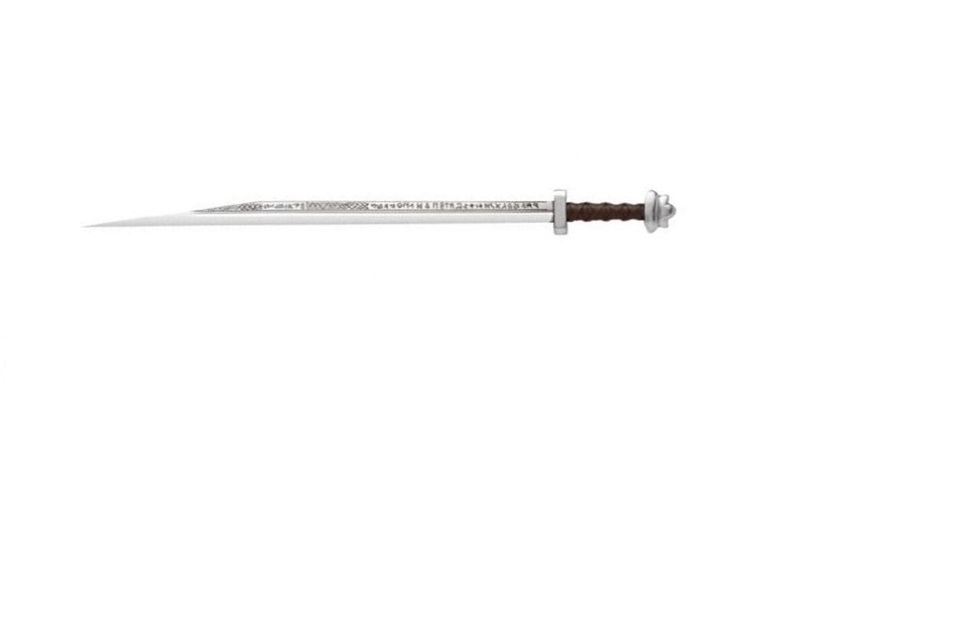
Seax (23” blade).
This is an example of a typical Seax sword. The point is similar to the tanto point, however, it would not meet the criteria we are proposing for ninja swords because the straight line at the tip is not roughly the width of the blade.
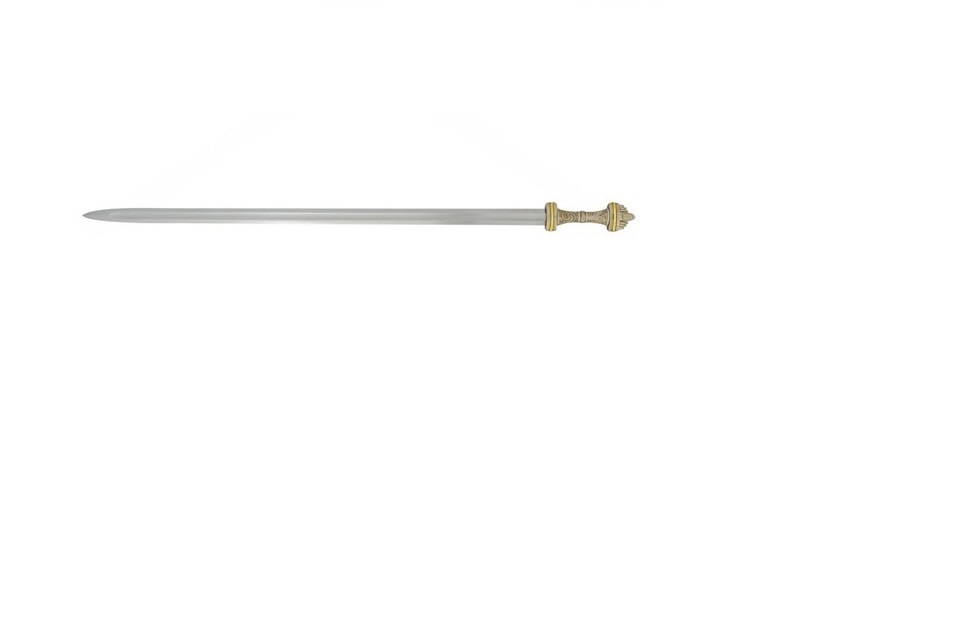
Anglo Saxon sword (31” blade).
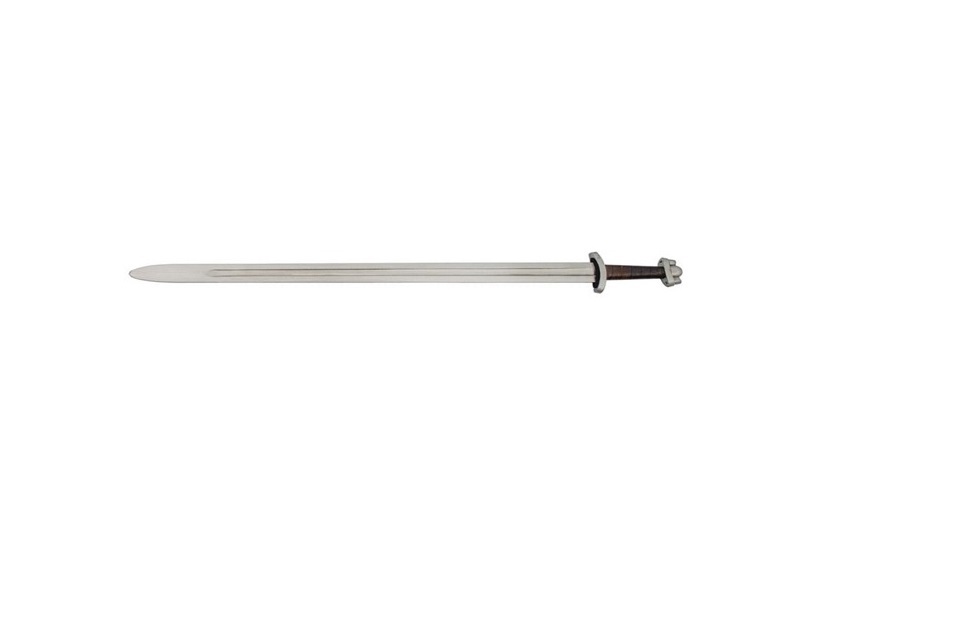
Viking sword (24” blade).
5. General defences
5.1. There are specific defences that apply to the list of prohibited offensive weapons. These defences relate to a specific set of circumstances or conditions. Anyone who can prove that they are under these circumstances or meet these conditions means it may be lawful for the person to manufacture, sell, hire, offer for sale or hire, expose or have in his possession for the purpose of sale or hire, lend or give to any other person or possess himself a prohibited offensive weapon to which Section 141 of the Criminal Justice Act 1988 applies.
5.2. Section 141 of the Criminal Justice Act 1988 currently makes available defences that can generally be applied to all the offensive weapons on the prohibited list in respect of:
-
The weapon is antique (over 100 years old).
-
Functions carried out on behalf of the Crown or of a visiting force.
-
The item being of historical importance.
-
Making the weapons available to a museum or gallery in certain circumstances.
-
Educational purposes.
-
Production of certain films or certain television programmes.
-
Theatrical performances and rehearsals of such performances.
5.3. For curved swords, there are further specific defences.
-
Made before 1954.
-
Made at any other time according to the traditional methods of sword making by hand.
-
Religious reasons (this includes for zombie-style knives and machetes as well).
-
Religious ceremonies (this includes for zombie-style knives and machetes as well).
-
Use in permitted activities (for example a historical re-enactment or sporting activity).
-
Blunt.
5.4. We are considering whether it would be appropriate to provide all these defences (as in paragraphs 5.2 – 5.3.) to ninja swords.
5.5. We would welcome views on whether these defences should apply to ninja swords.
6. Questionnaire
Providing a legal description for ninja swords
Question 1: Do you agree with the government’s legal description of ninja swords?
YES/NO (delete as appropriate)
Question 2: Are there any further features that we should consider to be included?
YES/NO (delete as appropriate)
Please give reasons (max. 250 words)
Prevalence of ninja swords
Question 3: Do you own a ninja sword?
If no, please go to question 4.
YES/NO/NA (delete as appropriate)
Question 3a: Where did you purchase your ninja sword/s?
Online/In-store/Both/Other (delete as appropriate)
If other, please specify (max. 250 words)
Question 3b: How much did your ninja sword/s cost? Please provide an answer in GBP (£)
Question 4: Do you manufacture ninja swords in England and Wales?
If no, please go to question 5.
YES/NO (delete as appropriate)
Question 4a: As a manufacturer, please provide details of (max 250 words):
The average number of units manufactured annually?
The number of units that you currently have in stock?
Question 5: Do you sell ninja swords in England and Wales?
If no, please go to question 6.
YES/NO (delete as appropriate)
Question 5a: As a retailer, please provide details of (max 250 words):
The average number of units you sell annually in England and Wales?
The average retail price of the units?
The number of units you currently have in stock?
Question 5b: How many employees does your firm have?
Question 6:
As part of this consultation, we are trying to determine the size of the market and circulation of ninja swords. If applicable, please provide any further evidence or information on how many ninja swords are currently in circulation or sold annually in England and Wales.
Applying defence and exemptions to possessing a ninja sword
Question 7: Do you agree with the proposed defences and exemptions relating to ninja swords?
YES/NO (delete as appropriate)
Question 8: Are there any further defences that we should consider to be included?
Please give reasons (max. 250 words)
Other
Question 9: Have you got any other comments?
YES/NO (delete as appropriate)
Please give reasons (max. 250 words)
About you: Respondent’s Information
Please use this section to tell us about yourself. Providing this information is voluntary. Please be assured that responses will be treated as personal data by the Home Office in compliance with government guidance on holding personal information.
- Full name
- Company name/organisation, if applicable
- Job title or capacity in which you are responding to this consultation exercise (for example, member of the public or chairman of a representative body), if applicable
- Contact details:
- Email address or;
- Main address including postcode
Thank you for your response.
7. Annex A: List of prohibited offensive weapons list
Criminal Justice Act 1998.
Section 141 of the Criminal Justice Act 1988, provides that it is an offence for any person to manufacture, sell or hire, offer for sale or hire, expose or have in his possession for the purpose of sale or hire of or lending or giving to any other person certain specified weapons.
The Criminal Justice Act (Offensive Weapons) Order 1988 (S.I 1988/2019) (as amended) provides that the following are specified weapons for the purpose of section 141:
-
a knuckleduster, that is, a band of metal or other hard material worn on one or more fingers, and designed to cause injury, and any weapon incorporating a knuckleduster;
-
a swordstick, that is, a hollow walking-stick or cane containing a blade which may be used as a sword;
-
the weapon sometimes known as a “handclaw”, being a band of metal or other hard material from which a number of sharp spikes protrude, and worn around the hand;
-
the weapon sometimes known as a “belt buckle knife”, being a buckle which incorporates or conceals a knife;
-
the weapon sometimes known as a “push dagger”, being a knife the handle of which fits within a clenched fist and the blade of which protrudes from between two fingers;
-
the weapon sometimes known as a “hollow kubotan”, being a cylindrical container containing a number of sharp spikes;
-
the weapon sometimes known as a “footclaw”, being a bar of metal or other hard material from which a number of sharp spikes protrude, and worn strapped to the foot;
-
the weapon sometimes known as a “shuriken”, “shaken” or “death star”, being a hard non-flexible plate having three or more sharp radiating points and designed to be thrown;
-
the weapon sometimes known as a “balisong” or “butterfly knife”, being a blade enclosed by its handle, which is designed to split down the middle, without the operation of a spring or other mechanical means, to reveal the blade;
-
the weapon sometimes known as a “telescopic truncheon”, being a truncheon which extends automatically by hand pressure applied to a button, spring or other device in or attached to its handle;
-
the weapon sometimes known as a “blowpipe” or “blow gun”, being a hollow tube out of which hard pellets or darts are shot by the use of breath;
-
the weapon sometimes known as a “kusari gama”, being a length of rope, cord, wire or chain fastened at one end to a sickle;
-
the weapon sometimes known as a “kyoketsu shoge”, being a length of rope, cord, wire or chain fastened at one end to a hooked knife;
-
the weapon sometimes known as a “manrikigusari” or “kusari”, being a length of rope, cord, wire or chain fastened at each end to a hard weight or hand grip;
-
a disguised knife, that is any knife which has a concealed blade or concealed sharp point and is designed to appear to be an everyday object of a kind commonly carried on the person or in a handbag, briefcase, or other hand luggage (such as a comb, brush, writing instrument, cigarette lighter, key, lipstick or telephone)
-
a stealth knife, that is a knife or spike, which has a blade, or sharp point, made from a material that is not readily detectable by apparatus used for detecting metal and which is not designed for domestic use or for use in the processing, preparation or consumption of food or as a toy;
-
a straight, side-handled or friction-lock truncheon (sometimes known as a baton);
-
a sword with a curved blade of 50 centimetres or over in length; and for the purposes of this sub-paragraph, the length of the blade shall be the straight-line distance from the top of the handle to the tip of the blade;
-
the weapon sometimes known as a “zombie knife”, “zombie killer knife” or “zombie slayer knife”, being a blade with—
-
a cutting edge;
-
a serrated edge; and
-
images or words (whether on the blade or handle) that suggest that it is to be used for the purpose of violence.
-
-
the weapon sometimes known as a “cyclone knife” or “spiral knife” being a weapon with—
-
a handle,
-
a blade with two or more cutting edges, each of which forms a helix, and
-
a sharp point at the end of the blade.
-
Restriction of Offensive Weapons Act 1959
The Restriction of Offensive Weapons Act 1959 prohibits the supply of flick knives and gravity knives but does not have the exemptions or defences that can apply to the offensive weapons prohibited by the 1988 Act. It also prohibits the possession of flick knives and gravity knives in private.
Flick knives and gravity knives are defined in section 1 of the Restriction of Offensive Weapons Act 1959 (as amended) as:
(a) any knife which has a blade which opens automatically—
-
from the closed position to the fully opened position, or
-
from a partially opened position to the fully opened position, by manual pressure applied to a button, spring or other device in or attached to the knife, and which is sometimes known as a “flick knife” or “flick gun”; or
(b) any knife which has a blade which is released from the handle or sheath thereof by the force of gravity or the application of centrifugal force and which, when released, is locked in place by means of a button, spring, lever, or other device, sometimes known as a “gravity knife”,
